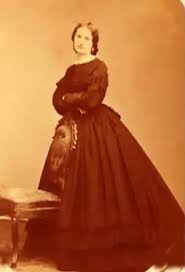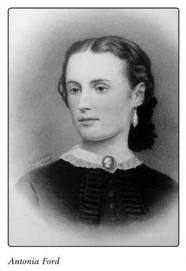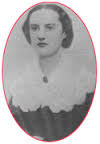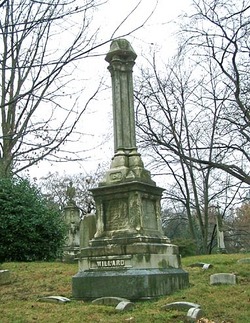 Stuart’s Femme Fatale, Antonia Ford, was a gorgeous and Seductive Secession Spy, during the Civil War. Ford played an alluring and sophisticated conduit for General J.E.B. Stuart, relaying Union intelligence to Confederate forces, including Stuart’s Scouts, led by Colonel John S. Mosby, the leader of a band of Confederate rangers in Northern Virginia.
Stuart’s Femme Fatale, Antonia Ford, was a gorgeous and Seductive Secession Spy, during the Civil War. Ford played an alluring and sophisticated conduit for General J.E.B. Stuart, relaying Union intelligence to Confederate forces, including Stuart’s Scouts, led by Colonel John S. Mosby, the leader of a band of Confederate rangers in Northern Virginia.
Ford’s youth and beauty were assets she used in intelligence gathering. When her father opened the family’s home, which was located halfway between Washington, D.C. and Manassas, as a gathering spot for Union officers, she had ample opportunity to charm Union soldiers and steal their secrets. On October 7, 1861, Stuart presented Ford with a “commission” as an honorary aide-de-camp, ordering she be “obeyed, respected and admired” as such. Instead, however, the document helped get her thrown in jail. The Stuart commission reads,
“TO WHOM IT MAY CONCERN:
Know ye: that reposing special confidence in the patriotism, fidelity and ability of Miss Antonia Ford, I, James E.B. Stuart, by virtue of the power vested in me, as Brigadier General in the Provisional Army of the Confederate States of America, do hereby appoint and commission her my honorary aide-de-camp, to rank as such from this date.
She will be obeyed, respected and admired by all lovers of a noble nature.
Given under my hand and seal at the headquarters, Cavalry Brigade, at Camp Beverly, this seventh day of October, A.D., 1861, and the first year of our Independence.
James E.B. Stuart
Brigadier General, C.S.A”
 Antonia Ford, was born on July 23, 1838, at Fairfax Court House, Virginia and was the daughter of a prominent merchant and secessionist, Edward R. Ford. Antonia was living a life of quiet comfort when the Civil War began. She was 23 years old and unmarried. Her home was located across the road from the Fairfax Court House. Antonia lived a life of privilege and was educated at the Buckingham Female Collegiate Institute in Buckingham, Virginia and learned the social graces of the Southern Belle at an early age.
Antonia Ford, was born on July 23, 1838, at Fairfax Court House, Virginia and was the daughter of a prominent merchant and secessionist, Edward R. Ford. Antonia was living a life of quiet comfort when the Civil War began. She was 23 years old and unmarried. Her home was located across the road from the Fairfax Court House. Antonia lived a life of privilege and was educated at the Buckingham Female Collegiate Institute in Buckingham, Virginia and learned the social graces of the Southern Belle at an early age.
Antonia’s brother Charles enlisted in the Confederate Army, serving as a lieutenant in J.E.B. Stuart’s Horse Artillery, before losing his life in combat at the Battle of Brandy Station and the family opened its home to Southern troops stationed near the court house.
When the Army of the Potomac moved out of Washington, DC, in June 1861 on its way to what would become the First Battle of Bull Run, its path led through Fairfax Court House. After a skirmish, Southern forces evacuated the town and the Union troops occupied it. The Ford home became a boarding house for Union officers, whom contemporaries described Antonia as “beautiful and refined”, who also obtained valuable information from Union officers that were staying in her home. She listened to conversations and reported what she heard to Stuart’s troops located near her home. In addition, she is said to have sometimes worked in conjunction with Rose O’Neal Greenhow, a Confederate agent in Washington, D.C.
Just before the Battle of Second Manassas in August 1862, she saved Southern troops from certain disaster by reporting a Union plan to use Confederate colors to draw them away from their assigned positions. Because no one could be prevailed upon to deliver the message for her, she drove herself 20 miles by carriage through the rain and past Union troops to deliver the intelligence to General Stuart.
In December 1862, when Union General Edwin Stoughton set up headquarters at Fairfax Courthouse, Antonia relayed information about the Federals’ movements to Stuart and Mosby.
In the early months of 1863, to fortify the federal capital, the Union authorities sent more troops to Fairfax Court House, under the command of General Edwin Stoughton. Antonia seems to have cultivated a friendly relationship with General Stoughton. They went riding through the countryside together so often that their relationship became the source of gossip and concern among the general’s own troops.
On March 8, 1863, General Stoughton hosted a party for his mother and sister, who had come down from Vermont to visit him. The party was held at the Ford residence, where the two women were staying. It was a rainy and windy night, but the soiree was a great success. By 1 a.m. the last carriage of guests departed, and everyone went to bed.
A little after 2 a.m. Colonel John S. Mosby and two dozen raiders slipped into Fairfax. Thanks to Antonia’s intelligence, Mosby was aware of the Union encampments in the area. Mosby’s raiders were wearing Federal issue gum ponchos to protect them from the rain and they managed to pass through the drowsy pickets unchallenged. An advanced guard had captured the only sentry on duty and the telegrapher.
 Mosby and five men went to the residence of Dr. William Gunnell, a few hundred yards north of the courthouse, where General Stoughton’s headquarters was located. They banged on the front door, announcing loudly that they had an important dispatch for the General. One of the general’s staff answered the door and was greeted by Mosby and a Colt revolver. Under gunpoint, the soldier led the Rebels to Stoughton’s bedroom. The general was sleeping soundly after the evening’s festivities and there were champagne bottles on the bedside table. Mosby pulled the covers off Stoughton and the groggy general demanded to know what was going on. In one of his audacious bluffs, Mosby told Stoughton that the Confederate cavalry under General Stuart had surrounded the courthouse.
Mosby and five men went to the residence of Dr. William Gunnell, a few hundred yards north of the courthouse, where General Stoughton’s headquarters was located. They banged on the front door, announcing loudly that they had an important dispatch for the General. One of the general’s staff answered the door and was greeted by Mosby and a Colt revolver. Under gunpoint, the soldier led the Rebels to Stoughton’s bedroom. The general was sleeping soundly after the evening’s festivities and there were champagne bottles on the bedside table. Mosby pulled the covers off Stoughton and the groggy general demanded to know what was going on. In one of his audacious bluffs, Mosby told Stoughton that the Confederate cavalry under General Stuart had surrounded the courthouse.
Stoughton had been a West Point classmate of Fitzhugh Lee, nephew of General Robert E. Lee and he asked to be brought to his old friend, and Mosby agreed. But Lee was with Stuart’s cavalry miles away in Culpeper. They set out at 3:30 am, just in time to get through the federal lines before daybreak. A few of the prisoners managed to escape along the way, but Mosby had pulled off a spectacular feat, capturing a brigadier general, two captains, 30 prisoners and 58 horses without one shot being fired!
In Washington, Secretary of War, Edwin Stanton became unhinged regarding the raid and immediately dispatched his top Secret Service Agent, Lafayette Baker, to the Fairfax Courthouse, to ferret out the conspiracy and bring the culprits to justice. Baker’s attention quickly focused on prominent local secessionists. Edward Ford and several other citizens were arrested on March 9, but he was soon released and suspicion then fell on his daughter, Antonia.
Baker inserted his own operative, Frankie Abel, who quickly gained Antonia’s confidence, who shared General Stuart’s letter of commission, which sealed Antonia Ford’s fate. Baker immediately ordered Ford’s arrest and transfer to Washington DC, about fifteen miles to the northeast. On March 16 1863, she was searched and found in possession of contraband correspondence and a handful of Confederate money. Baker took those items from her and ordered her into confinement in the Old Capitol Prison, charged with espionage. A prisoner exchange with the Confederacy was arranged on May 20, 1863. Antonia resumed her spying and was rearrested and incarcerated in Washington, D. C.
 Imprisonment undermined Antonia Ford’s health, but her arresting officer, Major Joseph Willard, fell in love with her and lobbied for her release. He obtained it seven months later, after which he proposed to her. Antonia accepted, he resigned his commission in the Union army, and the couple were married on March 10, 1864. They settled in Washington, D. C., where his family owned the renowned Willard Hotel. Antonia never fully recovered her health and died seven years later on February 14 1871, at the age of 33, her husband never remarried. Antonia Ford Willard rests at the Oak Hill Cemetery in Washington D.C.
Imprisonment undermined Antonia Ford’s health, but her arresting officer, Major Joseph Willard, fell in love with her and lobbied for her release. He obtained it seven months later, after which he proposed to her. Antonia accepted, he resigned his commission in the Union army, and the couple were married on March 10, 1864. They settled in Washington, D. C., where his family owned the renowned Willard Hotel. Antonia never fully recovered her health and died seven years later on February 14 1871, at the age of 33, her husband never remarried. Antonia Ford Willard rests at the Oak Hill Cemetery in Washington D.C.
General J.E.B. Stuart’s Femme Fatal, Antonia Ford, served the Confederate cause in a way that many of her gender could not have accomplished. Antonia had the stealth and innate ability to use her charms and wiles in order to obtain the intelligence demanded in order for the Confederacy to accomplish what was necessary inside the Union lines.
Bummer


She carried out her missions and still ended up marrying one of her Union opponents – she may be the most amazing of all the spies in this series.
Louis,
A fairly new female spy to the “old guy.” A gal that knew what she wanted and knew how to get results. More power to her! Thanks for the read.
Bummer